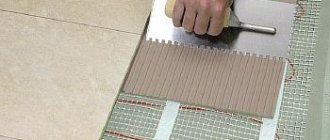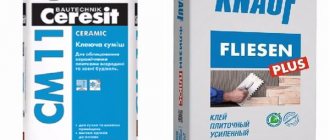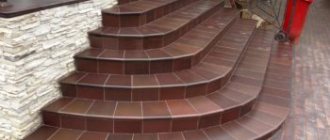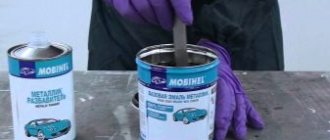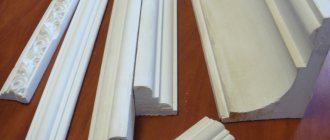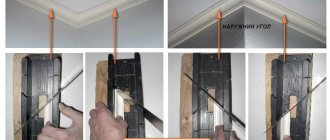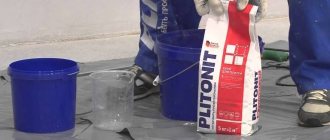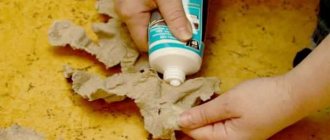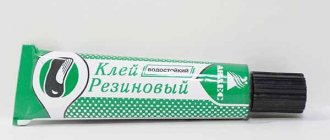If you are planning to start renovating your bathroom in the near future, then most likely you are faced with the task of laying tiles. This material today is known for its excellent technical characteristics, which make it possible to use tiles not only in the bathroom, but also in other rooms.
For laying tiles, a special tile adhesive is used, which is mainly sold in dry form. In this article we will tell you how to dilute tile adhesive so that the repair is carried out with high quality.
Types of mixtures
To lay tiles on the floor, you need to buy a ready-made mixture. It comes in several types:
- Cement. It is considered convenient and affordable. The components present in the composition have the same dispersion, the solution is mixed quickly and evenly. It is necessary to follow the manufacturer's instructions, which indicate how to dilute tile adhesive.
- Two-component. It has a low hardening time. It is necessary not only to know how to dilute tile adhesive, but also to establish proportions for preparing the mixture in small doses. This is necessary for stable performance of the work, and you should not worry that the resulting portion will dry out and be unusable.
- Epoxy. This glue cannot be diluted with water. You need to buy a liquid base and a reaction catalyst. How to dilute this type of tile adhesive? The 2 components are mixed and thoroughly rubbed together until a homogeneous and thick mixture is obtained.
When preparing glue, you must not only follow the proportions and recommendations of the manufacturer, but also follow the rules and techniques. If all parameters meet the standards, the composition will have the declared characteristics and high-quality adhesion. If you know how to carry out the work, you can make glue that allows you to carry out repairs in a relaxed atmosphere.
Proper mixing of your own adhesive composition
To replace the finished composition, it is wise to make high-quality tile adhesive with your own hands, and even save money! The recipe for such a solution is quite simple and includes the available ingredients: sand, water and cement, but sometimes lime may be needed.
The proportions of dry ingredients are usually prepared five to one. If you add more sand, the mass will become stronger, but less plastic, and it will be much more difficult to apply it to the surface, and with slight mechanical damage, the tile will disappear completely.
In order to lay tiles in the house yourself, this option is the most acceptable. To improve strength, it is necessary to mix either slaked lime or PVA glue into the composition, as well as folk remedies - washing powder or liquid soap. It is necessary to strictly consider the amount of liquid used. Preparing glue at home is quite simple, but using a ready-made purchased solution, you can not only save free time, but also get a high-quality mixture for work.
From the video you will learn even more:
Component Selection
When analyzing the topic of how to properly dilute tile adhesive, you should familiarize yourself with the selection of suitable components. The environment, such as temperature, is of particular importance. Attention to detail affects not only the consistency and characteristics of the solution, but also the glue consumption per 1 square meter. m. The following points are important:
- Water. Most manufacturers believe that mixing should be done using clean water. But no one indicates that the liquid should be drinkable. The unsuitability of process water lies in the presence of impurities, acids and alkalis that affect the properties of the solution.
- Temperature. The preparation of the composition should be carried out at a temperature of 5 to 40 degrees. But the best indicator is the room norm - 18-24. Under such conditions, the components react quickly, and there will be no need to prepare the solution for a long time.
- Temperature difference. The mortar that will be used when laying tiles must be prepared from seasoned materials. This means that the water and the building mixture must be at the same temperature. It is advisable to keep them in the room longer so that they become equal in warmth to the air.
Working at room temperature stabilizes glue consumption per 1 square meter. m. In the cold, the product deteriorates, and calculating its quantity is not so easy. And in hot weather, moisture quickly leaves the solution. Another important factor that affects product characteristics is the cleanliness of the mixing container.
Before carrying out work, the container must be cleaned thoroughly, removing frozen residues of the previous solution, as well as removing plaque on the walls. During mixing in such a container, there will be no chemical effect on the glue. The same requirement applies to a construction mixer and a drill attachment. Clean containers and a stirring device reduce the number of lumps, helping to achieve an even consistency.
Specifications
The main characteristics of the most popular glue of the Unis Plus series are presented in the table.
| Characteristic | Index | Possibilities |
| Adhesion | 1.25 MPa | Provides strong adhesion to the base not only of tiles, but also of heavier materials such as porcelain stoneware and natural stone |
| Mixture consumption (when applying a layer of 1 mm) | 3.5 kg/m2 | Economical packaging, low material consumption |
| Operating temperature | From – 50 to 70 degrees | High level of heat and frost resistance |
| Usage time | 180 min | It is recommended to dilute in small portions |
| Permissible layer thickness | 15 mm | |
| Drying time | About 24 hours | |
| Work temperature | +5 — +30 degrees | |
| Average installation time | 20 minutes | |
| Weight held | Up to 50 kg/m2 |
Craftsmen without experience in carrying out repair work of this type often make mistakes in choosing the appropriate adhesive solution.
To ensure strong adhesion to the base, it is better to seek advice from a specialist in the store, and also carefully read the characteristics indicated on the product packaging.
Preparation
Before performing work, you need to inspect the wall or floor. Uneven surfaces with cracks and old glue are not suitable for repair. It is important that the surface is smooth and free of previous coating.
These requirements apply to walls and floors. Wallpaper or newspaper must be removed. The cracks are sealed using putty. After leveling, the wall is treated with a primer.
Preparation
When laying tiles on the bottom, a floor mixture is applied to the cleaned floor. How to dilute tile adhesive? A description of the process is on the glue packages. Similar information can be found on the packaging of Ceresit, Unis, Plitonit, and Moment products. The applied primer or floor mixture should sit for a day; only the next day should it be prepared and applied.
The breeding procedure is as follows:
- You will need a clean container in which to prepare the mixture.
- You need to fill it with tap water, the temperature of which should be +15…+20 degrees.
- The amount of water should be equal to the volume indicated on the package. Each manufacturer may have nuances in what proportions to dilute tile adhesive.
- The mixture is gradually poured into the water, the resulting mass is stirred for 3-5 minutes.
- When the mass has become homogeneous, it should sit for 5 minutes, and then mix it again.
- The resulting glue can be used for 3-4 hours.
This is all the instructions on how to dilute Eunice tile adhesive. Checking the readiness of the glue is done as follows: use a spatula to take out the mixture, and then turn it over. The resulting mixture should not drain; its thickness should be such that the mass can stay on the spatula for some time.
Preparation of glue
It is important to maintain proportions. How to dilute tile adhesive? The process may vary depending on the product. The store-bought glue contains:
- cement;
- additives: minerals and polymers;
- sand;
- plasticizer
How to dilute tile adhesive without a mixer? Although there is a plasticizer in the mixture, it can be purchased separately. A separately purchased plasticizer is used instead of water or mixed with water in an amount of 50% to 50%. The finished consistency has enhanced properties in comparison with the mixture obtained with water. The sand must be dry and sifted to prevent lumps.
Some manufacturers create products from slaked lime. It has plasticizer properties. As a rule, cement grade M-400 is used. It can withstand a load of 400 kg/cm2 area. To independently prepare tile adhesive, you must use M-500 or M-600.
Features and scope of use
The basic composition of Yunis brand tile adhesives is approximately the same. It includes cement and mineral fillers: regular and quartz sand, gypsum, dolomite and others. To improve the technical parameters, each product is enriched with various chemical additives: modifiers, plasticizers, adhesion enhancers, etc.
The quality of Unis products is not inferior to that of tile adhesives from world-famous brands. All products have the necessary certificates of conformity confirming their characteristics. Eunice adhesives can be used for finishing children's institutions, hospitals, clinics, without violating safety standards.
Many compositions are suitable not only for ordinary tiles, but also for porcelain stoneware, since they have a high degree of adhesion with the following substrates:
- plaster;
- concrete, including cellular concrete;
- cement screed;
- asphalt;
- brick;
- plasterboard (PGP, GKL, GVL);
- slag concrete;
- aerated concrete.
Some products are suitable only for interior work, others are also suitable for finishing facades, paths, plinths, terraces, gazebos and other types of outdoor objects. There are adhesives for heated floors, swimming pools, and for various complex substrates. Some tile adhesives can easily be used to glue glass mosaics or natural and artificial stone.
The products form a durable layer that does not collapse over time in a dry or damp room. A number of building mixtures can be used to level floors with small differences in height; other means are suitable for stairs and floors in shopping centers with high traffic. In addition, the use of Unis adhesives is possible in bathrooms, saunas, baths, because moisture-resistant adhesives can withstand even direct contact with water.
Correct mixing
The quality of the finished solution, as well as the completeness of the process, depend on the correctness of the procedure:
- Do not add water to the solution. In this case, many lumps appear that are difficult to stir. The actions should be reverse. First, water is poured into the container, then a little solution is added. It is advisable to use a mixer. The amount of water is chosen according to the manufacturer’s recommendation.
- The procedure of adding powder to water has another advantage. Not only is stirring faster, but it also creates 2 layers of solution. The top one is dense; consistency is assessed by it. The lower one is a little thinner, but it is brought to condition during the period that is spent on producing a solution from the surface.
Manufacturers of dry mixes emphasize that the solution should be mixed a second time. This is required not only to break up any lumps that have appeared, but also to restore consistency. The resulting composition sets quickly, but it must be left for the time indicated by the manufacturer (at least 5 minutes). And then the mixer is processed again. This is required to restore the consistency and maintain the properties of the solution for 20-60 minutes.
You should learn about the duration and speed of mixing from the manufacturer’s recommendations. Some indicate that you can breed by hand. Manufacturers record recipes for preparing mixtures. How to dilute Ceresit tile adhesive? The packaging indicates the water consumption per 1 kg of mixture.
Recommendations
Do not rush while stirring. It is necessary to accurately assess the consistency of the solution. To do this, dial a little on the trowel, and then tilt the tool. If the solution falls off in pieces, then you need to increase the amount of water.
The amount of liquid should be increased only when mixing the glue for the first time. After 2 mixings, if the glue thickens or begins to clump during work, then you should not add water. It is advisable to use a mixer to mix the solution. This is necessary to restore its consistency for a while, which will help finish the job.
If the solution flows or slides, then some time is needed for partial setting, and the next portion is prepared with the required amount of liquid. If the adhesive composition holds securely, then the mixture can be used.
Choice
For tile adhesive to be effective, you need to understand the intricacies of its choice. It is important to pay attention to the following parameters:
- Adhesion. Indicates how much the adhesive can bond the material to the surface. For a quality product this indicator will be 1.1-1.4 MPa.
- Freezing time. Usually it is 3 hours. Dilution must be done before work. Approximately 20 minutes are spent on application and the same amount on adjustment.
- Tiscotropicity. It means how much the tile slides after it is fixed to the surface. The indicator should not be more than 5 minutes.
- Temperature. It is important when using glue on surfaces with special temperatures. If the glue will be diluted outdoors in the fall or spring, then you need to choose a cold-resistant mixture. And when working in hot weather, you should purchase glue with a high heat resistance rating.
There is a special type of tile adhesive - white. It is used when working with transparent mosaic or white stone for cladding. Dilution of glue is carried out according to the same principle as the others. Its main advantage is its invisibility and speed of drying.
How to use?
To use Unis 2000 glue correctly, you must follow the recommendations of specialists:
- you need to apply it to the surface of both tiles and walls, after which the surfaces covered with glue are carefully connected;
- if the substrate is well prepared, the glue will cope with the task most effectively;
- the base is freed from water and dust particles, and the uneven terrain is smoothed with sandpaper.
- there should be no coatings, decorative materials, oil or bitumen stains left, as all this can reduce the level of adhesion;
- per 1000 mm of base, the deviation from the ideal relief can be a maximum of 1 mm.

